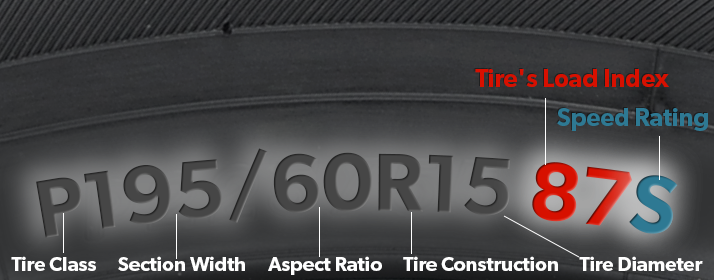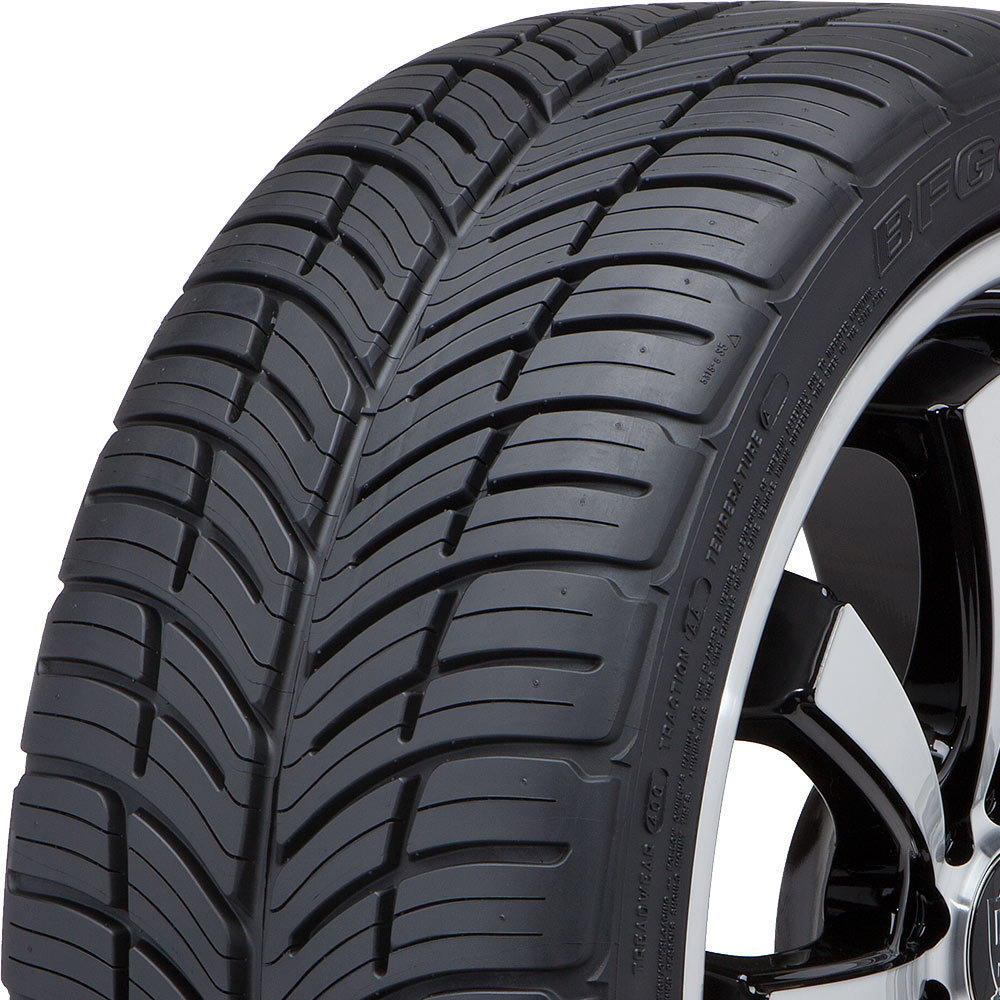Contents
WHAT EXACTLY IS TIRE LOAD INDEX?
When the super smart engineers designed and built your car, they crunched some numbers and determined exactly how much weight it could carry safely based on the right tire size and pressure. This is what we call the “tire load index.” The tires that come on your vehicle will have the proper load index, so stick to that number or higher when you purchase new tires. You can also check the vehicle’s manual to find the recommended tire size and load rating.

The numbers and letters displayed at the end of the series on your sidewall match what is referred to as “description of service”. It indicates the tire load index (also known as the load-carrying capacity or load rating) and the tire speed ranking. The load index indicates the maximum capacity of carrying or how much weight a tire will support at full air pressure. The speed rating represents the optimal speed that the tire can safely maintain over time. In a word, it is the maximum speed that the tire can handle before it is no longer performs as designed.
If you’re either lost or need only know the ranking for tires, or if you don’t know what the index for tire load or Z speed implies, you’re in the right place. In this post, you’ll figure out what these enigmatic codes on your tires say; how much weight your tires can carry, and the maximum speed capability when the tire is properly inflated.
Don’t know how to find your tire load index? We are here to help you. All you have to do is to find the two or three numbers at the end of your tire size — it’s the fancy, technical name for the long row of letters and numbers that surround your tire — following the single letter.
For example, at the end of the tire size, you see “88S”, so your tire’s load index is 88, the letter S is the speed ranking. You wonder what it means. In a broader sense, if the tire load index is higher, the tire can take more weight safely. To find out how much weight the tire can carry, you will need a tire load index chart. In our example, we have the tire with an 88 tire load index. It means that the tire will be able to carry 1,235 pounds at maximum tension of air. If you increase this number for a single tire by four, your car’s full ability will be an impressive 4,940 pounds.
The numbers of the tire load index correspond to actual weight measurements, typically ranging from 739 lbs to 3,748 lbs for load index values, starting at 70 and going all the way up to 126. From the number of the tire load index, the load-carrying capacity depends – the higher the number of the index of tire load, the greater is the load capacity of carrying. If you want your tires to provide the vehicle’s maximum load as designed by the manufacturer, it’s necessary to maintain them regularly.
If you want to figure out the tire’s speed ranking to reference one letter at the end of the tire’s size, you can find the speed rating for all the tires made since 1991.
For determining the speed ranking, the letters are used in (mostly) alphabetical order. The speed rankings are not just about the speed. They also refer to the ride comfort, wear, and ability of cornering. Usually, the higher the speed ranking, the better control and handling you will have at higher speeds. The speed ranking is based on practical tests that the engineers do when new tires are designed, ensuring that the tires can safely reach the high speed.
There are the next – L, M, N, P, Q, R, S, T, U, H, Y, and (Y) among the most spread rankings. Every letter denotes the speeds beginning from 75 miles per hour. Below, you can find the transcription of every letter and to what speed each of it corresponds:
L – 75 mph; M – 81 mph; N – 87 mph; P – 93 mph; Q – 99mph; R – 106 mph; S – 112 mph; T – 118 mph; U – 124 mph; H – 130 mph; V – 149; Z – 149+ mph; W – 168 mph; Y – 186 mph; (Y) – 186+ mph.
Let’s return to our example. After the number 88, you see the letter S. It means that the tire has a speed ranking – 112 mph.
Z-speeds tires – are they the fastest one ever?
You might not even have heard about the Z-speed tires until you travel on — or even have thought about driving on — the Autobahn in Germany, for example. They sound quick, don’t they? Oh yeah, very quick, because they are. The Z-speed tires were aimed to express the highest-ranking of tire speeds in the whole automobile history when they were made for the first time – the speeds that surpass 149 miles. Are you excited? We hope you are.
Maybe, you don’t have any idea; the tires can have an even higher ranking of speeds (yes, the speed can be higher!) Since the Z-speed tires were introduced, the other tires with higher speed have been presented, such as W-speed, Y-speed, and (Y) speed tires. The tires with W, Y, (Y) speed ranking will handle the speeds of 168 to 186 miles per hour, such as those you’d meet in exotic cars.
Have you ever wondered how old your tires are? If it is interesting, there is a bit of information about it. It can sound strange, but, yes, like everything in our universe, the tires have their date of birth. You ask us where to find it. Here’s the answer – it is indicated on the right of the tire itself.
Wanna know how to find the index of the tire load and speed ranking? We’ll prompt how to do it.
You can find this on the sidewall of your tire. If it is not clear for you to understand, you can also look for it in the manual for the owners. The other way to know the tire load index and the speed ranking is to look inside your glove compartment, gas tank hatch, or the doorjamb from the driver’s side – anywhere that indicates your car’s right code. Anyway, a tire specialist is always ready to help you in resolving this task.
| Load- Carrying Capacity Index Ratings | |||||
|---|---|---|---|---|---|
| Load Index | Load (lbs) | Load Index | Load (lbs) | Load Index | Load (lbs) |
| 0 | 99 | 50 | 419 | 100 | 1764 |
| 1 | 102 | 51 | 430 | 101 | 1819 |
| 2 | 105 | 52 | 441 | 102 | 1874 |
| 3 | 107 | 53 | 454 | 103 | 1929 |
| 4 | 110 | 54 | 467 | 104 | 1984 |
| 5 | 114 | 55 | 481 | 105 | 2039 |
| 6 | 117 | 56 | 494 | 106 | 2094 |
| 7 | 120 | 57 | 507 | 107 | 2149 |
| 8 | 123 | 58 | 520 | 108 | 2205 |
| 9 | 128 | 59 | 536 | 109 | 2271 |
| 10 | 132 | 60 | 551 | 110 | 2337 |
| 11 | 136 | 61 | 567 | 111 | 2403 |
| 12 | 139 | 62 | 584 | 112 | 2469 |
| 13 | 143 | 63 | 600 | 113 | 2535 |
| 14 | 148 | 64 | 617 | 114 | 2601 |
| 15 | 152 | 65 | 639 | 115 | 2679 |
| 16 | 157 | 66 | 639 | 116 | 2756 |
| 17 | 161 | 67 | 677 | 117 | 2833 |
| 18 | 165 | 68 | 694 | 118 | 2910 |
| 19 | 171 | 69 | 716 | 119 | 2998 |
| 20 | 176 | 70 | 739 | 120 | 3086 |
| 21 | 182 | 71 | 761 | 121 | 3197 |
| 22 | 187 | 72 | 783 | 122 | 3307 |
| 23 | 193 | 73 | 805 | 123 | 3417 |
| 24 | 198 | 74 | 827 | 124 | 3527 |
| 25 | 204 | 75 | 852 | 125 | 3638 |
| 26 | 209 | 76 | 882 | 126 | 3748 |
| 27 | 215 | 77 | 908 | 127 | 3858 |
| 28 | 220 | 78 | 937 | 128 | 3968 |
| 29 | 227 | 79 | 963 | 129 | 4079 |
| 30 | 234 | 80 | 992 | 130 | 4189 |
| 31 | 240 | 81 | 1019 | 131 | 4289 |
| 32 | 247 | 82 | 1047 | 132 | 4409 |
| 33 | 254 | 83 | 1074 | 133 | 4541 |
| 34 | 260 | 84 | 1102 | 134 | 4674 |
| 35 | 267 | 85 | 1135 | 135 | 4806 |
| 36 | 276 | 86 | 1168 | 136 | 4938 |
| 37 | 282 | 87 | 1201 | 137 | 5071 |
| 38 | 291 | 88 | 1235 | 138 | 5203 |
| 39 | 300 | 89 | 1279 | 139 | 5357 |
| 40 | 309 | 90 | 1323 | 140 | 5512 |
| 41 | 320 | 91 | 1356 | 141 | 5677 |
| 42 | 331 | 92 | 1389 | 142 | 5842 |
| 43 | 342 | 93 | 1433 | 143 | 6008 |
| 44 | 353 | 94 | 1477 | 144 | 6173 |
| 45 | 364 | 95 | 1521 | 145 | 6393 |
| 46 | 375 | 96 | 1565 | 146 | 6614 |
| 47 | 386 | 97 | 1609 | 147 | 6779 |
| 48 | 397 | 98 | 1653 | 148 | 6844 |
| 49 | 408 | 99 | 1709 | 149 | 7165 |
| 150 | 7385 | ||||
WHY IS TIRE LOAD INDEX IMPORTANT?
The tire load index tells you how much weight your tire can carry, and overloading your tires is never a good idea! When you put too much weight on your tires, you can cause damage and wear them down prematurely. Even worse, you run the risk of experiencing a tire blowout. Imagine trying to carry a box full of cement blocks. Just like your legs would buckle under the weight, your tires can completely give out if they’re overloaded.
USING THE TIRE LOAD INDEX CHART
The tire load index lets you know the load carrying capacity of a tire. In other words, it’s the amount of weight your tire can support safely.
For example, if a tire has a load index of 92, it can support 1,389 pounds at maximum air pressure. Multiply that by four tires (4 x 1,389 = 5,556 pounds) to get your car’s maximum load carrying capacity. Never install tires with a lower load carrying capacity than the original tires that were factory installed on your vehicle.

Founder at Tiresout. Used to be working as an engineer at Bridgestone Tires Akron Technical Center. The responsibilities included but were not limited to technical computing, indoor & outdoor testing of new tires.
